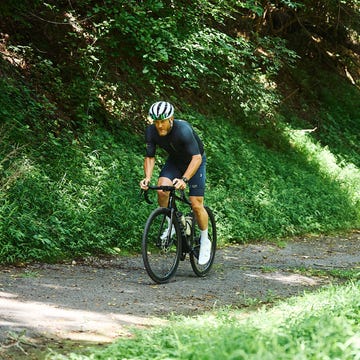Gravel riding is a popular and still-growing category of cycling. And while gravel bikes are common and widely available, equipment trends at the top of the sport are causing an upheaval in gravel equipment.
It is still unknown whether this trend is a fad that will flame out quickly, like 27.5-plus mountain bikes, or if we’re on the cusp of a new paradigm, like 1x drivetrains.
But it is a radical enough change to gravel equipment that I’m advising most riders currently shopping for a gravel bike—especially for racing—to wait to see where this evolution cycle is taking us.
Not long ago, 40 to 42mm seemed the preferred tire width for gravel riding and racing. But in the past year(ish), that’s been completely upended.
The latest trend dominating the competitive edge of gravel racing is using mountain bike tires—specifically, 29er cross-country mountain bike racing tires with light casings in widths ranging from 2.10 to 2.4 inches (53 to 61mm).
This is causing a massive shakeup and rendering new gravel race bikes outdated even as they launch. Because if your gravel bike can’t accommodate at least 53mm-wide tires—which most gravel race bikes can not—you'll miss out on the performance benefits this potentially game-changing shift has to offer.
Payson McElveen is one of the more visible gravel racers using big mountain bike tires. I reached out to him to ask what caused him to move to big tires. McElveen said he started riding on mountain tires after observing one of his competitors.
“Cole Paton took the leap and decided to run MTB tires at Big Sugar in the fall of 2023. That’s a big boy power course. He is a small climber type. The rest of us in the front group were on gravel tires. He was absolutely murdering us all day. It was all we could do to hang on in his draft most of the time.”
Soon after, McElveen started testing tires with his bike sponsor Allied, “The results were stunning, and it became clear very quickly that the industry has had it all wrong. MTB tires are better for all gravel riding and racing. By a lot. The end.”
I followed up with Cole Paton to ask why he chose to run mountain tires at Big Sugar in 2023. He told me, “It just made a lot of sense to me on a course like Big Sugar. Coming from a mountain bike background, I hated the feeling of getting jarred around, not having any grip, and constantly puncturing on sharp rocks. I studied the course, and I assumed there were enough corners on it to offset the weight and aero penalty with just the added grip of big tires.”
Like most riders, McElveen and Paton saw the unmistakable advantage of a larger mountain bike tire on the rockiest and roughest terrain. But what about the extra weight, rolling resistance, and aero penalty of the larger tires? Wouldn’t that be a disadvantage on the smoother and faster sections of the course?
This is the most surprising and potentially revolutionary learning from gravel racers who have tested mountain bike tires: Mountain bike tires are faster almost everywhere.
Paton said, “Once I tested it out, I was blown away. It rolled faster almost everywhere, even the smooth sections."
Meanwhile, as part of his testing, McElveen did multiple back-to-back laps on a smooth pavement climb comparing different tires from his sponsor Maxxis. He compared his times riding the 57 mm (2.25-inch) Aspen ST and the 45 mm Reaver file tread, “Their times were basically identical both up and down. That’s smooth pavement. PAVEMENT! Insane,” he exclaimed.
Word about the advantages of racing gravel on big tires quickly spread, and in 2024 more and more pros were seen with the biggest tires they could fit in their frames.
But there is a problem: Most popular gravel race bikes are not designed for the mountain bike tires McElveen and Paton had found so advantageous.
Canyon’s Grail gravel race bike, launched in late 2023, has just 42mm tire clearance. Trek launched its new Checkmate gravel race bike in August 2024 with a maximum stated tire clearance of 45mm. Cannondale launched its new Super X gravel racer in February 2025 with 48mm max clearance (rear, 51mm at the fork). Devinci just launched a new Hatchet with a max clearance of just 45mm.
The Santa Cruz Stigmata’s stated tire clearance is 50 mm, though Keegan Swenson occasionally gambles with clearance and, it appears, shoehorns 57-mm Maxxis Aspen tires into his bike.
Meanwhile, the Crux of the Specialized gravel racers has 47mm clearance, but, like Swenson, some riders look like they are running tires larger than officially recommended.
When conceived and designed, the Grail, Checkmate, and other gravel race bikes had adequate tire clearance. However, the mountain bike tire trend moved faster than the gravel frame production cycle.
I’ve messaged some of the companies mentioned above, and I can tell you they are aware of the trend and are considering how to react.
Tires are relatively cheap, easy, and quick to produce, so we should see many 50mm-plus gravel tires hitting the market in the coming months.
But some frame makers I’ve spoken with are concerned that this trend may be a fad, so they’re hesitant to commit significant resources to a long-term project like a carbon frame. But if they don’t, they risk being caught out if the trend goes mainstream.
I expect you will see prototype gravel frames with massive tire clearance under some top racers this year. But carbon bikes take a long time to progress from concept to mass production. So, even if Specialized. Trek, Cannondale, Canyon, and the other major players decide (if they haven’t already) to make frames to address this trend, you won’t be able to buy one for a while.
One of the things that will delay the rollout of gravel bikes adapted to new school tire widths is geometry. Tire size, especially when this big, significantly influences how a bike handles, so brands can’t simply copy/paste geo from their existing gravel bikes and add clearance. They must prototype and test new geometries designed for bigger gravel tires. That’s likely the most significant reason McElveen and Allied have built so many prototypes of the new Able—at least seven, based on the Instagram post above.
If you want to buy a gravel race bike today that is compatible with this cutting-edge thinking about gravel tire size, your options are limited.
The bike I’m most excited about isn’t available quite yet. Allied is close to launching a production version of the mule McElveen has been publicly riding and racing—mostly with Maxxis Aspen ST 2.25 inch (57mm) tires—for a long time. Allied hasn’t publicly stated the clearance of the new Able, but I think it could be as much as 61mm, allowing it to fit the 2.4-inch Aspen ST tire.
UPDATE: Allied lifted the cover off the new Able in early April. It features 57mm tire clearance, internal storage, internal routing, a threaded bottom bracket, UDH, and some aerodynamic tuning.
I also know of at least one other raceable gravel bike launching in June with clearance for 2.25 mountain bike tires.
Options available now include Lauf’s Seigla. Although this bike has been on the market for years, it’s only now that its impressive 57mm (2.25-inch) tire clearance is recognized for being so forward-looking. You can order this bike with Lauf’s Grit suspension fork or a rigid fork, and Lauf’s prices are extremely good, too, with complete bike prices starting at $2,750 for a carbon frame with wireless electronic shifting.
Another great value option is State’s brand new All Road V2 carbon bike. It fits up to 56mm tires and also has in-frame storage. Complete bike prices start at $2,299.
Giant’s Revolt—Paton’s bike—boasts 53mm (2.1-inch) clearance, which is better than most, although this seems like it’s on the minimum end of acceptable clearance for the mountain tire trend.
Spot’s Rallye also provides 53mm clearance, accomplished with remarkably short 415mm stays, which the brand attributes to the elevated driveside chainstay. The shorter chainstays should give this bike a lively feel. Meanwhile, the Rally’s front end is quite long and is designed to be paired with a 70mm stem. This long front and short stem philosophy originates from mountain bikes and enhances stability. Additionally, the Rallye features geometry that is corrected to accept a suspension fork without altering its fit or handling.
3T’s Extrema Italia checks a couple of compelling boxes. Not only does it boast 57mm tire clearance, but it’s also an aerodynamic frame and made in Italy. I have one of these in for testing, and I just fitted it with a set of 2.25-inch Vittoria Terreno XC tires. I will use this setup to test the speed of mountain tires for gravel myself.
The Otso Waheela C, another bike that has been on the market for several years (and is a personal favorite of mine), fits 53mm tires and is also geometry-corrected for a suspension fork.
If you want something more boutique, Seven makes the Gravel 758 , which features 58mm clearance. You can get one quickly, too: Seven recently launched its Rider Ready program, which promises a three-week turnaround. If you are willing to wait longer, almost unlimited custom options are available.
Another boutique titanium option is found in Mosaic’s GT-x-series bikes with 55mm tire clearance. For that matter, many custom frame builders would be willing to work with you to craft a fast gravel bike that fits big tires. However, a custom bike will have an extended lead time and cost much more than Lauf’s Seigla, which starts at a reasonable $2,740 equipped with SRAM electronic shifting.
There are also numerous drop bar mountain bikes with big clearance. These are great for adventure riding and bikepacking/touring but generally aren’t speedy and high-performance bikes suitable for fast riding and racing.
Another option is to scrounge an old 29er XC hardtail mountain bike and build it with drop bars. Remember that mountain bikes were designed for flat bars and mountain bike speeds, so the riding position and handling may not be ideal for gravel racing.
If you have no interest in racing gravel on mountain tires, many bikes are available. But if you like riding the latest and greatest, just wait: The gravel bike market is about to go wild.

A gear editor for his entire career, Matt’s journey to becoming a leading cycling tech journalist started in 1995, and he’s been at it ever since; likely riding more cycling equipment than anyone on the planet along the way. Previous to his time with Bicycling, Matt worked in bike shops as a service manager, mechanic, and sales person. Based in Durango, Colorado, he enjoys riding and testing any and all kinds of bikes, so you’re just as likely to see him on a road bike dressed in Lycra at a Tuesday night worlds ride as you are to find him dressed in a full face helmet and pads riding a bike park on an enduro bike. He doesn’t race often, but he’s game for anything; having entered road races, criteriums, trials competitions, dual slalom, downhill races, enduros, stage races, short track, time trials, and gran fondos. Next up on his to-do list: a multi day bikepacking trip, and an e-bike race.



















